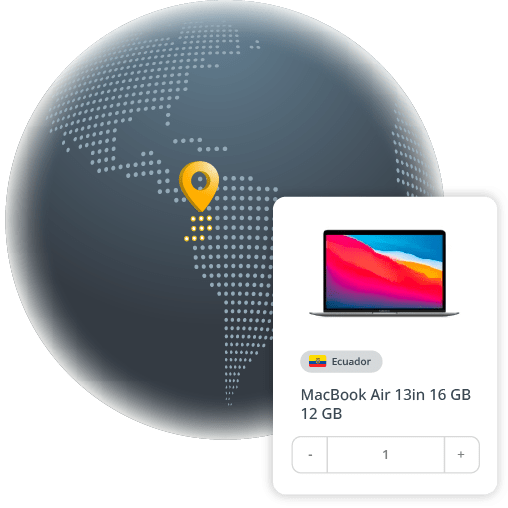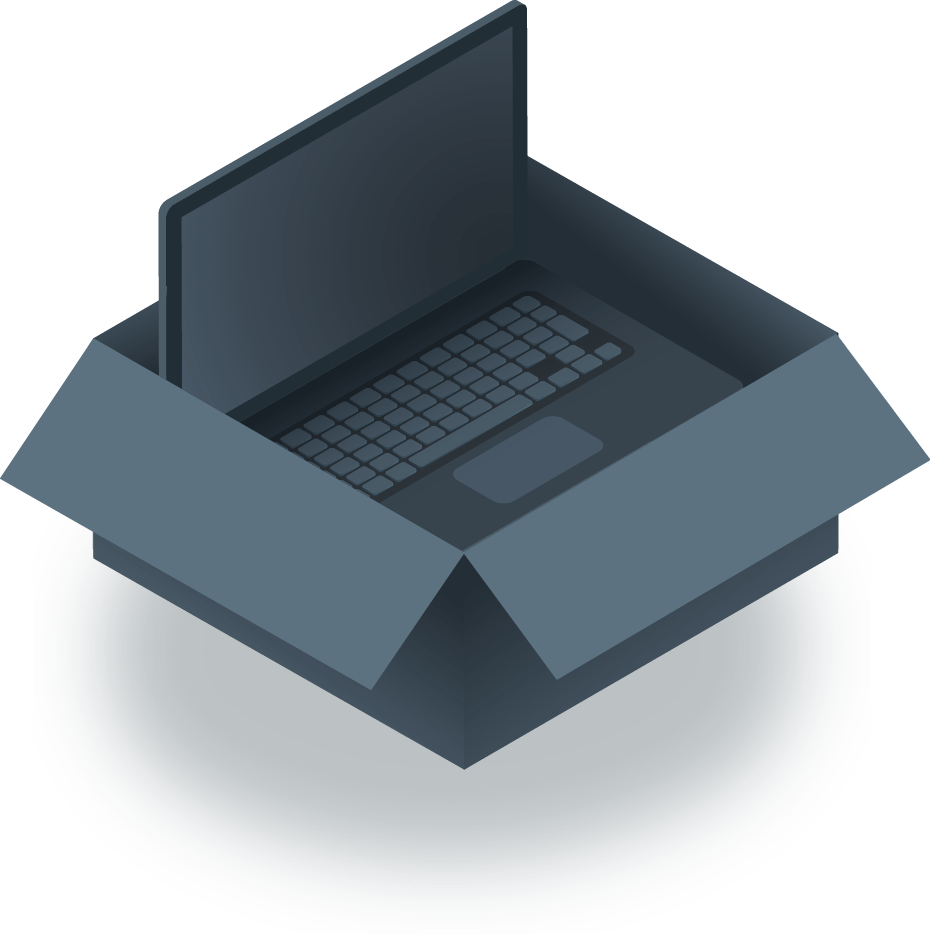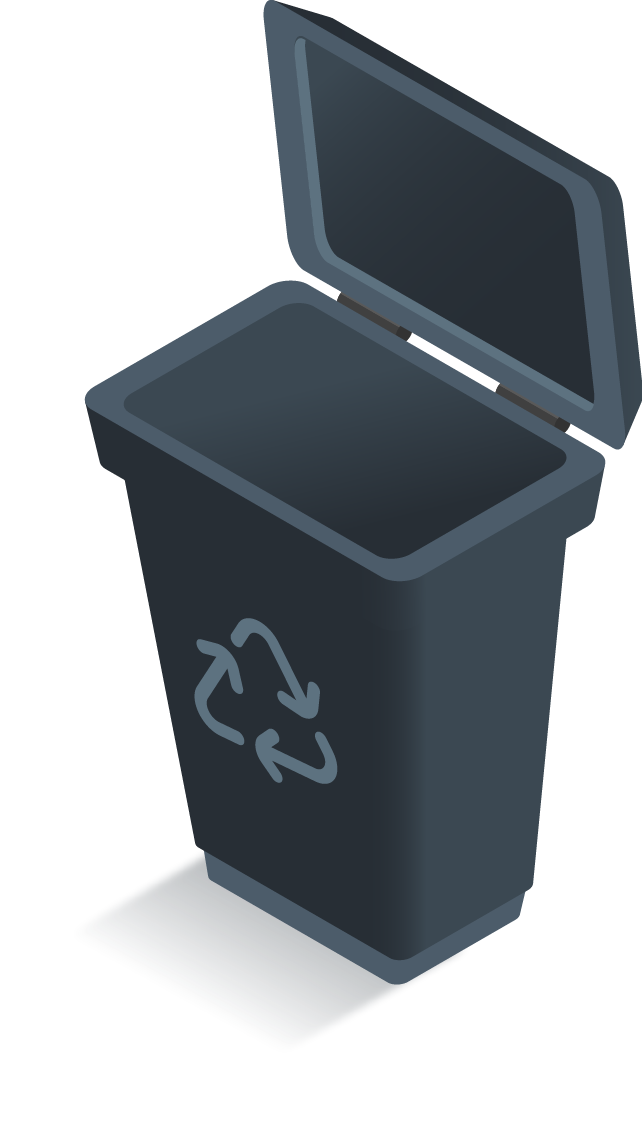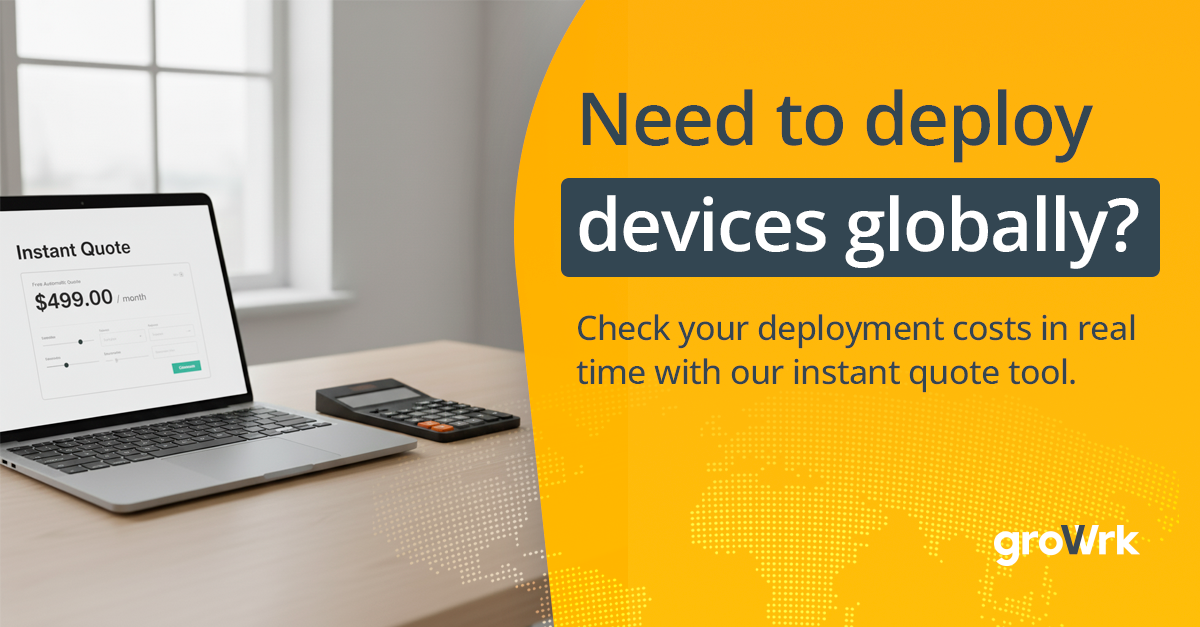How to send IT equipment to Ecuador
Need to send IT equipment to your remote teams in Ecuador? GroWrk makes cross-border tech management smooth and stress-free. Whether it’s laptops, servers, or any essential gear, we’ve got the secure and efficient delivery to Ecuador covered.

At a glance
Ecuador, located on the Pacific coast of South America, is quickly emerging as a key player in the region's tech landscape. With its expanding economy, improving IT infrastructure, and vibrant tech scene, Ecuador offers global businesses an ideal environment to enhance efficiency, cut costs, and maintain high standards of quality.
|
CURRENCY United States Dollar (USD) |
OFFICIAL LANGUAGE Spanish |
TIME ZONE Ecuador Time (ECT) GMT-05:00 |
|
CUSTOMS DUTY ON ELECTRONICS 15% VAT Typically 0-10% customs duties with a 15% VAT; specific exemptions may apply for certain products |
SHIPPING LEAD TIME 5-8 days Standard shipping times to Ecuador vary based on the origin and shipping method. |
IT OUTSOURCING MARKET Expected to grow significantly, with Ecuador positioning itself as a strong digital economy player for both local and international businesses. |
Overview of IT operations in Ecuador

Driving digital innovation: Ecuador is positioning itself as a major player in digital innovation. With projects aimed at improving internet access and enhancing tech services, the country is expanding into areas such as fintech, e-commerce, and digital solutions. This growing focus creates a fertile ground for businesses to develop and thrive.
State-of-the-art IT infrastructure: Ecuador is making significant strides in its tech infrastructure, from upgrading internet speeds to expanding its data center networks. These improvements are positioning the country as a competitive hub for cloud computing and digital services, making it an ideal destination for businesses seeking to enhance their online presence.
Sustainability focus: Ecuador is fully committed to creating a greener future. With government-led initiatives promoting the adoption of green technology, the country is fostering an environment that enables businesses to innovate without compromising on sustainability. It’s a win-win for the planet and your business.
Highly skilled workforce: Ecuador is building a robust workforce in key tech areas like software development, cybersecurity, and systems management. Thanks to investments in tech education, the country is becoming an increasingly appealing destination for businesses seeking top-tier IT talent to drive their innovation.
Business-friendly environment: Ecuador offers a stable and welcoming business environment, with attractive tax policies and strong data protection laws. The country is open to foreign investment, offering numerous opportunities for international companies to expand and thrive.
Solid cybersecurity measures: Ecuador is stepping up its cybersecurity efforts with a robust legal framework designed to protect critical infrastructure, digital systems, and user data. These measures provide businesses with a secure environment to operate in, knowing that data and systems are well-protected.
A thriving tech hub: Cities like Quito and Guayaquil are emerging as exciting tech hubs, supported by a growing startup ecosystem, government initiatives, and increased access to venture capital. Ecuador’s tech scene is evolving rapidly, offering numerous opportunities for businesses seeking to innovate and expand in the digital landscape.
Shipping IT equipment to Ecuador: What you need to know
| Customs regulations |
|
| Duties and taxes |
|
| Required documentation |
|
| Import restrictions |
|
| New vs. Used equipment |
|
| Customs clearance process |
|
| Penalties or fines for non-compliance |
|
Checklist for sending laptops to Ecuador
When shipping laptops to Ecuador, it’s important to follow a few best practices to ensure the process goes smoothly, and your equipment arrives safely and on time. Here are some helpful shipping tips:

Select trusted couriers: Choose reliable couriers such as GroWrk, DHL, UPS, FedEx, or Correos del Ecuador for international shipping. These carriers offer tracking services and have experience navigating Ecuadorian customs procedures.
Check service levels: Select the appropriate shipping option based on urgency. Express shipping (3-6 days) for high-priority deliveries. Standard shipping (7-14 days) for cost-effective options.
Use high-quality packaging: Secure laptops with sturdy, padded boxes and protective materials like bubble wrap, foam inserts, or air cushions to prevent damage during transit.
Disassemble where possible: If shipping accessories like chargers, docking stations, or monitors, package them separately to prevent damage. Remove detachable components if applicable.
Label clearly: Ensure the recipient’s name, address, and contact details are correctly labeled. Mark the package as "fragile" to encourage careful handling.
Accurate product descriptions: On the commercial invoice, provide a detailed and accurate description of the laptop, including its brand, model, and serial number. Inaccurate descriptions may cause customs delays.
Value declaration: Declare the correct value of the laptop to avoid under- or over-declaring, which could lead to customs inspections or fines. The declared value determines any applicable duties and taxes.
Customs declarations: All shipments into Ecuador must go through customs clearance. Include: Ecuadorian Customs Declaration (Declaración Aduanera de Importación - DAI), commercial invoice, and packing list.
Proof of origin: If applicable, include a certificate of origin to qualify for reduced tariffs under agreements like the Ecuador–EU Multiparty Trade Agreement or CAN (Andean Community) agreements.
Understand import duties & taxes: Laptops are typically duty-free (0%) under Ecuador’s tariff schedule. However, they are subject to 12% VAT and may incur 0.5% FODINFA tax (child development fund). Additional courier handling and customs processing fees may apply.
Pre-pay duties and taxes: Some couriers allow for pre-paid duties and taxes to simplify customs clearance and prevent the recipient from facing unexpected charges upon arrival.
Protect against loss or damage: Consider purchasing shipping insurance for high-value laptops to protect against loss, theft, or damage during transit.
Compliance with Ecuadorian regulations: Laptops with wireless connectivity may require registration with ARCOTEL (telecommunications regulatory agency) for commercial imports. Single units for personal use are usually exempt.
Use tracking tools: Major couriers provide real-time tracking—monitor shipments closely to anticipate customs clearance updates and delivery progress.
Stay in touch with the recipient: Notify the recipient about the expected delivery timeline, tracking updates, and any customs-related requirements to avoid delays.
Expect weather and seasonal delays: Delivery may be affected by rainy season flooding, volcanic activity, or high-volume holidays like Christmas and Black Friday. Plan accordingly for urgent shipments.
Ecuadorian domestic delivery options: For final delivery, consider Correos del Ecuador, Servientrega, TramacoExpress, or DHL Ecuador for reliable local service.

Average cost of IT Equipment in Ecuador
Laptops (Business Grade):
- Mid-range: $600 - $1,200
- High-end: $1,200 - $2,500+
High-end models such as Apple MacBook Pro, Dell XPS, and Lenovo ThinkPad are priced on the higher end.
Monitors (Business Grade):
- Standard: $150 - $300
- Ultrawide/4K: $550 - $1,000
Monitors from trusted brands like Dell, Samsung, and LG typically range within these prices, with 4K or ultrawide models costing more.
Desktops (Business Grade):
- Standard Desktop PC: $600 - $2,200
- Workstation Desktop (for high-performance tasks): $2,200 - $6,000+
Prices depend on the brand and specifications, with options from HP, Lenovo, and Apple among the most common.
Printers (Laser):
- Standard Office Printers: $200 - $600
- High-Volume Printers: $900 - $2,700+
Leading brands such as HP, Canon, and Brother offer a wide range of models for office environments.
Public holidays & IT work hours to plan your shipment
Key public holidays in Ecuador:
- New Year’s Day – January 1
- Carnival (Mardi Gras) – Date varies (usually February or March)
- Good Friday – Date varies (usually April)
- Labour Day – May 1
- Independence Day – August 10
- Guayaquil Independence Day – October 9
- Day of the Dead – November 2
- Christmas Day – December 25
- Boxing Day – December 26
Typical work hours for IT professionals
- Standard workweek
- Most IT professionals in Ecuador work about 40 hours a week, typically from Monday to Friday. Office hours usually run from 8:00 AM to 4:00 PM or 9:00 AM to 5:00 PM. However, many tech companies now offer more flexible schedules, with some even allowing remote work as long as employees meet their expected hours.
- Overtime
- In Ecuador, overtime is regulated and generally kept to a minimum. If an IT professional works extra hours, they’re entitled to either extra pay or time off. Overtime pay is typically 1.5 times the regular rate, with higher rates for weekend or public holiday shifts.
- Public holiday work
- On public holidays like Labour Day, New Year’s Day, or Christmas, most offices will either close or operate with reduced hours. If IT professionals are required to work on these days, they usually receive premium pay or additional time off, ensuring they’re fairly compensated for their time.
What to consider when retrieving IT equipment from employees in Ecuador
| Local delivery and logistics services |
|
| Inventory management |
|
| Logistics challenges for remote locations |
|
| Equipment agreement with employees |
|
How to dispose of IT equipment in Ecuador
E-waste recycling:
- Certified E-Waste disposal: To stay compliant with Ecuador’s environmental laws, use certified e-waste disposal services. These services properly break down your IT equipment, handling items like batteries and circuit boards safely while minimizing environmental impact.
- Recycling centers: For smaller electronics, local recycling centers in Ecuador are a great option. However, for bulkier items like servers, you may need specialized services that comply with all relevant legal and environmental requirements when handling these devices.
Data Destruction
- Data wiping: Before disposing of any equipment, it’s crucial to erase all data from devices such as hard drives, SSDs, and phones. Ensure that you use certified data-wiping software to ensure that sensitive information is completely wiped and can’t be recovered.
- Physical destruction: If you want to be 100% certain that your data is permanently deleted, consider physically destroying your storage devices. Shredding or crushing them can ensure that no one can access the information, giving you extra peace of mind when disposing of your old gear.
Repurposing or donating
- Donating to charities: If your equipment is still in good working condition, consider donating it to local schools, nonprofits, or community groups in Ecuador. Donating your old tech is a great way to give it a second life while helping those who may not have access to such resources.
- Internal repurposing: If your company is constantly upgrading its IT gear, consider repurposing older devices for less demanding tasks within the organization. This extends the life of your equipment and keeps departments that don’t require cutting-edge tech running smoothly.
Manufacturer take-back programs
Many tech manufacturers offer take-back programs that let businesses in Ecuador send back old devices for recycling or repurposing. These programs are great for ensuring responsible disposal and help you stay compliant with local environmental guidelines.
Certified E-Waste recycling providers
Always work with certified third-party disposal services that are recognized by Ecuador’s local authorities. These providers ensure that your IT equipment is recycled by environmental standards, handling all necessary paperwork to provide certificates of destruction or recycling to confirm that everything was disposed of properly.

Local IT Outsourcing Solutions in Ecuador
You can streamline your IT logistics and asset management with GroWrk’s comprehensive global solution. Whether it’s shipping equipment or managing IT assets across multiple regions, GroWrk helps you stay compliant and efficient every step of the way. Here’s why GroWrk is the ideal partner for managing your IT assets in Ecuador:

| 1. Wide global coverage |
GroWrk combines global IT outsourcing experience with an understanding of Ecuador’s local market. Whether you need help with technical aspects or regulatory matters, we’ve got you covered by making sure you stay compliant with local laws and follow industry best practices. |
| 2. End-to-end asset management |
Full IT Asset Lifecycle Management |
| 3. Intuitive platform for easy deployment |
With GroWrk, you can track and manage all your IT assets across Ecuador in one place. Our platform helps simplify logistics, ensuring your team stays organized and on top of everything. |
| 4. Smooth delivery and equipment retrieval |
We ensure seamless delivery of IT devices, like laptops, to your employees across Ecuador. We also manage returns when employees leave, making the process quick and cost-effective for your business. |
| 5. Compliance with Ecuadorian import regulations |
GroWrk makes sure all your shipments comply with Ecuador’s import regulations, including customs procedures and tax requirements. From VAT management to customs duties, we’ve got it covered, ensuring your IT gear arrives without any delays. |
| 6. Efficient repairs and maintenance |
We offer fast repair and maintenance services to keep your devices in top shape. GroWrk works quickly to minimize downtime and keep your teams productive throughout Ecuador. |
| 7. 24/7 Support for peace of mind |
Our support team is available 24/7 to assist with asset management, logistics, or shipping concerns. Whether it's during office hours or after, GroWrk is always ready to support your IT operations in Ecuador. |
Procure, configure, and deploy your IT devices from one platform


